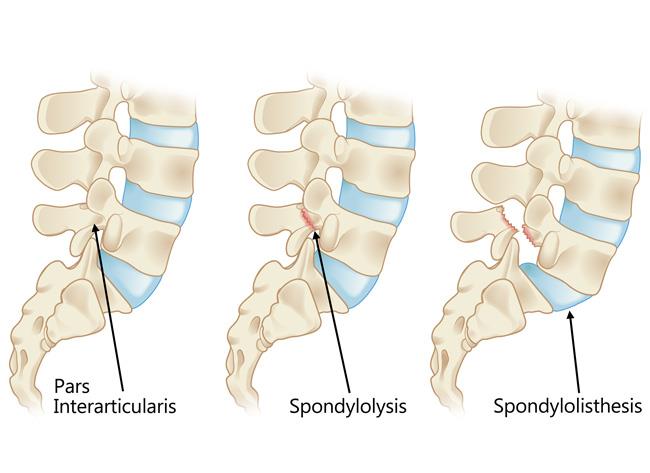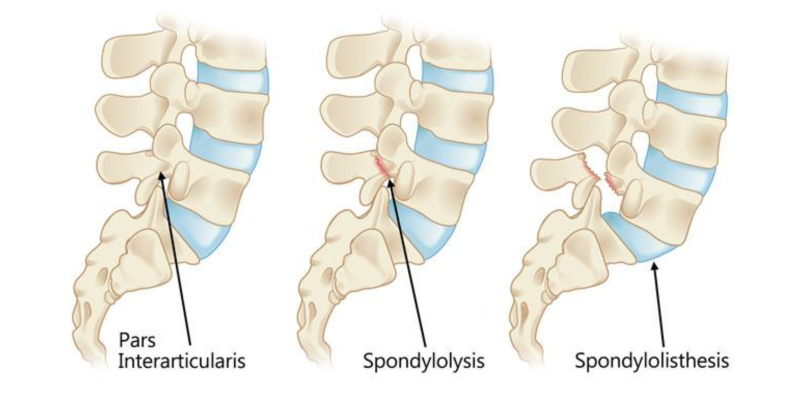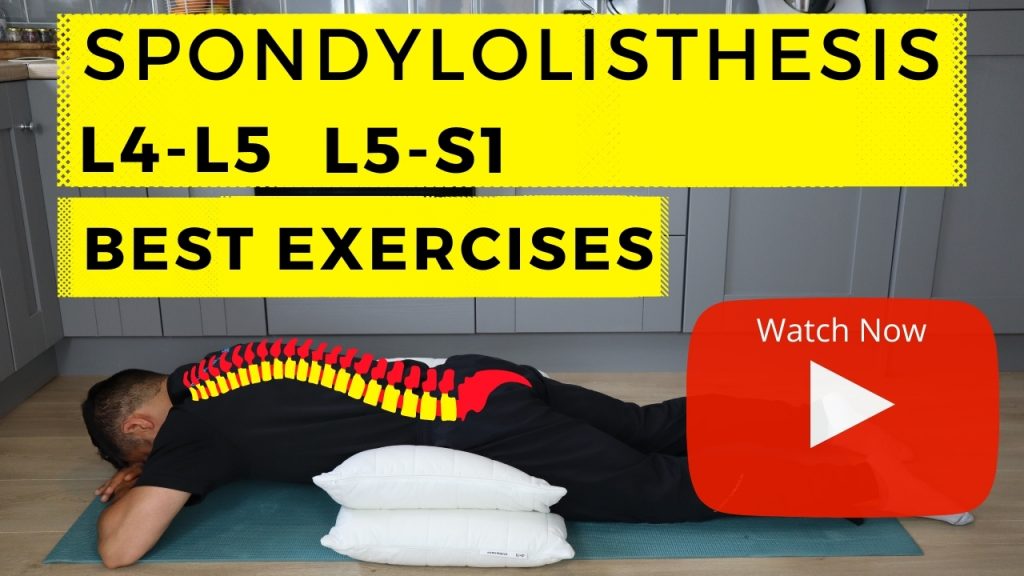Spondylolysis is a crack or stress fracture in one of the vertebrae, the small bones that make up the spinal column. The injury most often occurs in children and adolescents who participate in sports that involve repeated stress on the lower back, such as gymnastics, football, and weight lifting.
In some cases, the stress fracture weakens the bone so much that it is unable to maintain its proper position in the spine—and the vertebra starts to shift or slip out of place. This condition is called spondylolisthesis.
For most patients with spondylolysis and spondylolisthesis, back pain and other symptoms will improve with conservative treatment. This always begins with a period of rest from sports and other strenuous activities.
Patients who have persistent back pain or severe slippage of a vertebra, however, may need surgery to relieve their symptoms and allow a return to sports and activities.
Spondylolysis and Spondylolisthesis
Spondylolysis and spondylolisthesis are different spinal conditions—but they are often related to each other.
Spondylolysis
In spondylolysis, a crack or stress fracture develops through the pars interarticularis, which is a small, thin portion of the vertebra that connects the upper and lower facet joints.
Most commonly, this fracture occurs in the fifth vertebra of the lumbar (lower) spine, although it sometimes occurs in the fourth lumbar vertebra. The fracture can occur on one side or both sides of the bone.
The pars interarticularis is the weakest portion of the vertebra. For this reason, it is the area most vulnerable to injury from the repetitive stress and overuse that characterize many sports.
Spondylolysis can occur in people of all ages but, because their spines are still developing, children and adolescents are most susceptible. Many times, patients with spondylolysis will also have some degree of spondylolisthesis.
Spondylolisthesis
If left untreated, spondylolysis can weaken the vertebra so much that it is unable to maintain its proper position in the spine. This condition is called spondylolisthesis. Spondylolysis (pars defects) create a change in the biomechanics of the spinal segment. Because the connection between the facet joints is broken, the bone above can begin to gradually slip forward on top of the bone below. This “slip” caused by the spondylolysis is called spondylolisthesis. As the slip progresses, the disc between the bones is subjected to increased stress, leading to accelerated disc degeneration.
Doctors commonly describe spondylolisthesis as either low grade or high grade, depending upon the amount of slippage. A high-grade slip occurs when more than 50 percent of the width of the fractured vertebra slips forward on the vertebra below it. Patients with high-grade slips are more likely to experience significant pain and nerve injury and to need surgery to relieve their symptoms.
 (Left) The pars interarticularis is a narrow bridge of bone found in the back portion of the vertebra. (Center) Spondylolysis occurs when there is a fracture of the pars interarticularis. (Right) Spondylolisthesis occurs when the vertebra shifts forward due to instability from the pars fracture. Picture source: here
(Left) The pars interarticularis is a narrow bridge of bone found in the back portion of the vertebra. (Center) Spondylolysis occurs when there is a fracture of the pars interarticularis. (Right) Spondylolisthesis occurs when the vertebra shifts forward due to instability from the pars fracture. Picture source: here
Different grades of Spondylolisthesis
Spondylolisthesis is graded according to the severity of the slippage. This is known as the Mayerding classification. Spondylolisthesis occurs in different degrees based on the amount of slippage of one vertebra on another. These degrees of slippage are medically termed grades. Accordingly, grade I is 0%-25%, grade II is 25%-50%, grade III is 50%-75%, grade IV is 75%-100%, and grade V is >100%.
Spondylolysis and Spondylolisthesis Cause
Overuse
Both spondylolysis and spondylolisthesis are more likely to occur in young people who participate in sports that require frequent overstretching (hyperextension) of the lumbar spine—such as gymnastics, football, and weight lifting. Over time, this type of overuse can weaken the pars interarticularis, leading to fracture and/or slippage of a vertebra.
Genetics
Doctors believe that some people may be born with the vertebral bone that is thinner than normal—and this may make them more vulnerable to fractures.
Symptoms of spondylolisthesis
Many people may not realize they have spondylolisthesis because it does not always cause symptoms.
Lower back pain – which is usually worse when you’re active or when you’re standing, and is often relieved by lying down pain, numbness, or a tingling feeling spreading from your lower back down your legs (sciatica) – this happens if the bone in the spine presses on a nerve tight hamstring muscles stiffness or tenderness in your back curvature of the spine (kyphosis). The severity of these symptoms can vary from person to person.
Diagnosis
Medical history and general health and symptoms will be taken. If you participate in sport more specifically high intensity, repetitive sports such as gymnastic, powerlifting. Children who participate in sports that place excessive stress on the lower back are more likely to have a diagnosis of spondylolysis or spondylolisthesis.
Imaging studies including MRI and CT scan can show a slip, as well as narrowing (stenosis) or compressed nerves in the spinal canal. The CT scan and MRI scans are usually obtained with the patient lying flat, however, sometimes a slip may only be obvious when standing or bending forwards. This is why your neurosurgeon or spinal surgeon will sometimes obtain flexion, extension, and standing X-rays, and occasionally a CT myelogram.
Treating spondylolisthesis
The way spondylolisthesis is treated depends on your symptoms and how severe they are.
In most cases, non-surgical treatments will be recommended first.
Non-surgical treatments
Your physical therapist will provide you a conservative treatment to improve your pain and your symptoms. Back braces used to be recommended for some people with spondylolisthesis, but they’re no longer used because there are concerns that they may weaken your spine without improving symptoms. We have prepared you a sample of rehabilitation exercise routine that you can follow at home.
Back surgery for spondylolisthesis
Surgery may be recommended if non-surgical treatments do not work and your symptoms are severe, persistent, or suggest you have a compressed nerve in your spine.
The type of operation you need depends on the type of spondylolisthesis you have. The surgery usually involves fusing the slipped bone in your spine to the bones next to them using metal screws and rods, and a piece of your own bone taken from an area nearby. The screws and rods are usually left in place permanently.
In some cases, the disc between the bones in your spine may also be removed. It’ll be replaced by a small “cage” containing a bone graft to hold the bones in your spine apart.

